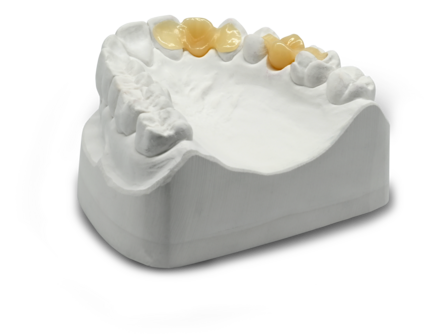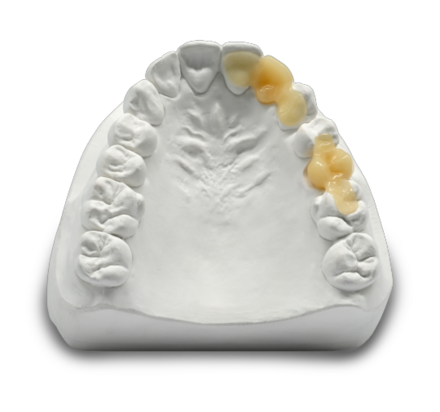A Maryland bridge - also known as adhesive bridge or bonding bridge - can be used for the high-quality and aesthetically pleasing restoration of anterior tooth gaps. It is a particularly gentle form of dental prosthetics. With this type of restoration, the supporting teeth are only lightly ground and the enamel is roughened using an etching technique. To attach the bridge, the dentists take an impression or scan of the prepared teeth as a basis to design and fabricate the bridge in the dental laboratory. The bridge is fixed to one or two adjacent teeth using a special adhesive material. Precisely fitting adhesive bridges can be made as ceramic-veneered partial constructions or from all-ceramic, they completely restore the function and aesthetics of the natural teeth.
Maryland bridge as a single and double-wing version
According to clinical studies, single-wing Maryland bridges have proven to be significantly better in practice than double-wing versions, especially in the case of single gaps in the anterior region. Here following you find the most important criteria:
Single-wing variant
-
Gentle preparation on the tooth substance: it is necessary the pre-treatment of only one tooth as support
-
Immediate detection of retention loss when the adhesive wing is detached
-
Improved oral hygiene through the use of dental floss at the proximal contact point to the neighboring tooth
-
Rational and economical fabrication of the restoration
Two-wing variant
-
Stiffness of the two support teeth and the adhesive joints: exposure to strong loading and shearing forces during jaw movements, especially when chewing
-
Consequence: high risk of unilateral detachment of the adhesive wing and thus loss of retention without being noticed or ignored by the patient with increased risk of caries under the detached adhesive wing
-
Solution: separation of the detached adhesive wing, smoothing of the tooth bonding surface with sealing using composite resin and transfer to the prognostically safe single-wing variant
Applications of the Maryland bridge
The Maryland bridge is an esthetic solution for closing gaps in anterior region. In the following sections, we look at its versatile areas of application in detail.
Anterior region
A Maryland bridge is used to close gaps in the anterior region, as the chewing load and pressure on the anterior teeth is lower than on the posterior teeth. In the upper jaw, the Maryland bridge is generally only used when an anterior tooth is missing. In the lower jaw, the Maryland bridge can replace up to three missing anterior teeth. The two-wing variant is recommended in this case. The prerequisites are that the adjacent supporting tooth or the two adjacent teeth are healthy and caries-free, have no large fillings and the tooth enamel is intact.
Gum disease
In patients with gum disease and periodontitis, with progressive destruction of the periodontium including bone and supporting fibers, deepening of the gingival pockets and a dysbiotic biofilm on the subgingival root surfaces, the Maryland bridge is an option for gap closure if an implant is not an option.
Long-term temporary restoration
A Maryland bridge is ideal as a functional and esthetically high-quality long-term temporary restoration until a dental implant is inserted after jaw bone augmentation.
Jaw growth and dentures
In children and adolescents without a completed growth phase of the jaw, the use of an implant is not possible. In this case, a Maryland bridge can be used to close the gap or as a long-term temporary restoration until the jaw has finished growing. Orthodontic measures can be supported by an adhesive bridge.
Choice of materials for the Maryland bridge
The materials of choice are a metal framework such as titanium or cobalt-chrome (CoCr) together with a biocompatible ceramic veneer, matched to the patient's tooth color. Alternatively, a gold framework with a ceramic veneer can be used.
At CADdent®, however, we usually make Maryland bridges from full zirconia for the framework and veneer. Here the advantages are:
-
Biocompatibility, no allergic reactions
-
Strength and durability in daily use
-
Aesthetics due to tooth-like color and translucency, blending in with the natural appearance of surrounding teeth
-
Low thermal conductivity, therefore reduced tooth sensitivity
-
Corrosion resistance to acids and therefore durability
-
Low plaque adhesion, therefore improved oral hygiene and reduced risk of infection
Advantages vs. disadvantages of the Maryland bridge
The advantages of using the Maryland bridge clearly outweigh the disadvantages. However, it is not suitable for all patients. In the following sections, we take a closer look at the advantages and disadvantages of this method.
Advantages:
-
Minimally invasive and painless, as there is little or no grinding of the neighboring teeth
-
Preservation of the tooth substance of the neighboring teeth
-
Highly aesthetic
-
The adhesive bridge can be loaded immediately
Disadvantages:
-
Detachment of the special adhesive and thus loss of retention of the adhesive bridge; however, possibility of immediate, uncomplicated repair by the dentist
-
Not suitable for patients who suffer from bruxism (teeth grinding), as the special adhesive detaches under constant pressure
CONCLUSION
A Maryland bridge is the best choice for children and adolescents with further jaw growth, especially in the case of a single gap closure in the anterior region. The adhesive bridge is ideal as a long-term temporary restoration for all groups of people with a healthy tooth status until an implant is inserted. Single-wing variants are recommended, especially for solo tooth gaps.

